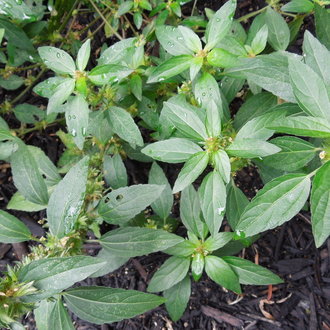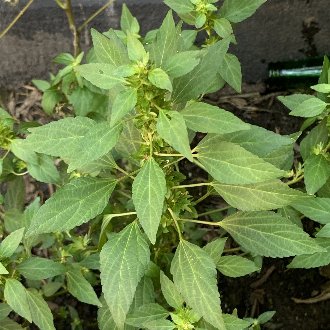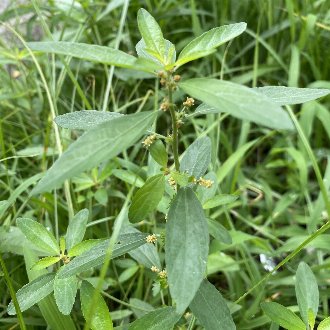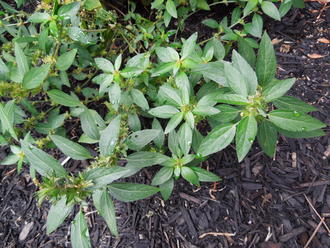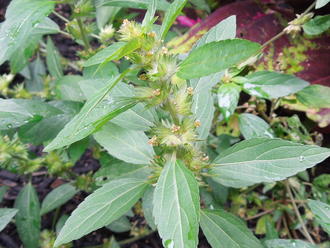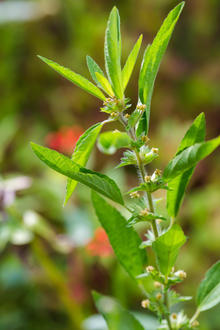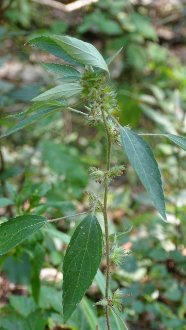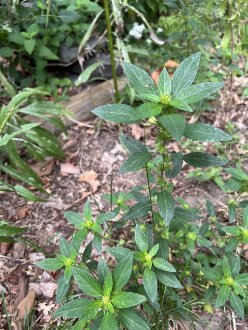Virginia Threeseed Mercury (Acalypha virginica L.)
Also known as virginia copperleaf, virginia mercury.
Although all of the major modern authorities consider it to be a separate, some older sources treated rhomboid mercury (Acalypha rhomboidea) as a variety of this species. As such, some materials still circulating occasionally treat these together and may list some material specific to A. rhomboidea including photos and/or written descriptions, as associated with this species.
↑Summary
An inconspicuous weedy annual native to eastern to central North America. Its name is midsleading: although it occurs in Virginia, it is more common farther north and west.
↑Range - Expand
| Legend | Color |
| Native | |
| Native or Expanded | |
| Extirpated | |
| Native or Not Present | |
| Native or Expanded or Not Present |
This map is based on our research. We have checked its accuracy to Level 3 ecoregions. Although this plant occurs somewhere in each of these regions, it may only occur in a small part of some or all of them.
↑Similar Plants
↑Habitat
Found in a variety of partly-shaded habitats on sites where soil has been exposed in late spring, after the emergence of most other vegetation. Natural habitats include open woods, especially rocky woods or clearings around rock outcroppings, partly-wooded cliffs, forest edges, and grasslands, including both Midwestern prairies and riverside meadows and prairies in the southeast. Anthropogenic habitats include abandoned fields, areas along roadsides and railroads, and partly shaded yards and gardens, particularly areas under trees that receive sunlight from the side and in areas with slightly poor soil. This plant can sometimes occur and reproduce in mowed lawns, where it reaches a tiny fraction of its potential size.
Prefers partial sunlight, needing at least a few hours of direct sunlight but preferring some shade. More abundant in nutrient-poor soils. Tolerates a range of soil textures including heavy clay soils, loam, and soil with a significant amount of rocky material, with some tolerance of sandy soils if soil pH is not too low. The exposure of soil that allows this plant to germinate can result from disturbance, but it is more likely to result at least in part from the habitat as a whole being rather sparse due to low nutrient availability and/or dry conditions.
We could not find reliable sources on the exact pH ranges of this species but it is usually more common in higher pH ranges, ranging onto alkaline soils and also found in neutral and slightly acidic soils but becoming progressively less common in more acidic (probably soil pH < 5.9) soils, which is related to its scarcity in the southeastern coastal plain.
Although not strictly dependent on fire, this species benefits greatly from fire, especially low-intensity fires that clear ground-level vegetation while leaving larger trees intact. These fires create nearly ideal conditions for this plant to establish, through removing competing vegetation, exposing the soil, and reducing nitrogen availability while increasing mineral availability. This species probably benefitted greatly from controlled burns to maintain savannas, widely practiced by Native Americans across much of its range, and it has probably greatly died back in distribution in response to fire suppression practiced following European Colonization of North America. It has also been locally extirpated from the northeast of its range in Maine and New Hampshire, where it was rare; this dieback may also be related to the loss of fire. Although this species has not been researched as heavily as some, a study of controlled burns in Illinois found it was the dominant herb that colonized after fire.
Relative to Acalypha rhomboidea, this species prefers slightly drier and less-fertile soils, but habitats that are slightly more stable. It ranges farther into the great plains reflecting its better adaptability to stable grasslands and prairies. The combination of it preferring higher pH but nutrient-poor soils is probably why this species is less common relative to A. rhomboidea in much of its range. Relative to slender threeseed mercury (Acalypha gracilens), this species is much less tolerant of acidic soils and does not range as far into the southeastern coastal plain.
↑Life Cycle
This species is an obligate summer annual. Its seeds germinate in late spring when temperatures warm, with some seedlings continuing to germinate into summer. As such it often germinates on sites that have experienced vegetation-clearing disturbances in spring, but it also can germinate on sites where the vegetation in spring is still relatively sparse.
The seeds are relatively large and plants quickly establish a robust taproot, giving this plant significant tolerance to growing-season drought.
Plants begin blooming in mid summer and continue into fall. Flowering is incremental, usually with only a few flowers opening at once. Flowers are wind-pollinated. Seeds occur in units of three, and under favorable conditions all three will mature, but if the plant is stressed, one seed will be aborted. Seeds mature as new flowers are blooming, and this process continues until temperatures cool, with the bloom period usually spanning 2-3 months.
Plants completely die down in late fall, with the exact timing driven by temperature and varying greatly both by year and by the site's microclimate.
↑Faunal Associations
This species, like other Acalypha, is more palatable to mammals than most plants in the spurge (Euphorbiaceae) family as it lacks the toxic sap possessed by most plants in that family, and it also has rather tender foliage. It is browsed by white-tailed deer throughout the growing season. However it tends to be avoided by livestock because it has an undesireable flavour.
The seeds, which are rather large and nutrition, are eaten by Mourning Doves and Swamp Sparrows, and likely by other native birds.
Two flea beetles, Hornaltica bicolorata and Margaridisa atriventris, eat the foliage of this and other Acalypha species.
We could not find any information about lepidoptera that feed on this species in particular, but the generalist fall armyworm (Spodoptera frugiperda), which prefers to eat grasses, has been recorded eating Acalypha and probably eats this species, but it is probably not a preferred food source.
↑Uses
This species is usually viewed as an inconspicuous or indistinct weed and most people either pay little attention to it or pull it out as a generic "weed". However it can be attractive in gardens. Large patches of it can have an attractive groundcover-like look, slightly reminiscent of pachysandra (which is related) but with more tender leaves.
It is infrequently used in ecological restoration projects because its seed is difficult to gather due to its incremental maturation time, in which a few seeds fall off a plant before the next become ripe.
To establish it in a new area, you can transplant a few robust plants mid-growing season, and then let it make seeds so it establishes on a wider scale in the following year. The best way to utilize this plant in gardens or ecological restoration projects is to know how to identify it, and then leave it in place when it comes up on its own. Although not always common, it is fairly widespread and will often colonize suitable habitat on its own.
↑Related Plants
Overlaps in range with several Acalypha species in various parts of its range.
↑Links & External Resources
• Acalypha virginica (Virginia Mercury) | Illinois Wildflowers (About This Site)
• Acalypha virginica (Virginia Threeseed Mercury) | USDA PLANTS Database (About This Site)
• Acalypha virginica | Go Botany (About This Site)
• Virginia Three-Seed Mercury | iNaturalist (About This Site)
• Acalypha virginica | Biota of North America Project (BONAP) (About This Site)
• Acalypha virginica | NatureServe Explorer (About This Site)
• Acalypha virginica | Flora of North America (About This Site)
• Acalypha virginica | Missouri Plants (About This Site)
• Virginia Three-seeded Mercury | Maryland Biodiversity Project (About This Site)
• Acalypha virginica L. (Virginia Three-seeded Mercury, Virginia Copperleaf) | Digital Atlas of the Virginia Flora (About This Site)



